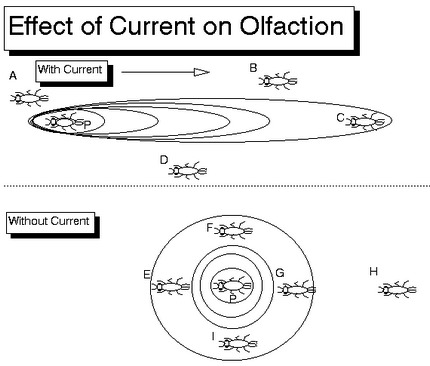Considering that Science is a stale read, I livened up my research by poring over pages of BASS forum datum, searching for “cable guy” wisdom on the use of scent on baits.
BASS fiends are more fun than fly fishermen, but only because they have so many more hang-ups (and such thin skins) …
Mention to a fly fisherman that he “coaches soccer,” and you get that screwed up face suggesting the joke was lost on him, whereas the bass crowd is already climbing over the bar intent on your arse …
In short, science suggests scent in fish is somewhat synonymous with taste, and it makes perfect sense. In humans scent is particulate matter mixed with air, and taste is particulate matter dissolved in spittle. Each sense being chemically discrete and can be experienced without the data intruding from one to the other.
Fish “smell” particles dissolved in water and their “taste” is the same medium, so the two senses have overlap.
The physics of water and scent is reasonably obvious. The rush of water downstream carries scent and forms a plume from the source of the dissolved solid. Lake water has much less of a current and therefore the scent area is a slowly widening circle from the source of the particulate.

Naturally my slow moving ditch water has neither appreciable current nor is it completely stagnant, so the chemical trail of any bait tossed within its banks will be slow in spreading.
That’s the good news.
Science drops the bombshell by suggesting polluted waters affect smell drastically, and even fish exposed in migration can suffer many weeks of scent impairment. Among the most drastic pollutants are metals, heavy or otherwise.
The worst of the worst being copper, which should send a cold chill up any fisherman’s spine …
Copper is most frequently deployed as an algaecide or fungicide. Significant amounts of copper in the water column result from farm field runoff from crops that are water intensive like rice or tomatoes.
As we’re discussing those drainage ditches that bisect California’s Central Valley, we know that copper is deployed wherever there is rice fields, which comprises about half the state.
Naturally its the Northern half – which means all that copper is in the Sacramento, and pushed down to Southern California via the aqueduct, and spat into San Francisco Bay after permeating the Delta.
Copper is apparently linked to the decline of California’s Coho salmon population given its ability to destroy taste and smell in salmonids, making them unable to detect waterborne predators like Pike minnow, Otters, and everything else the southern water districts conjure up as a Jihadist of salmon.
So while you’re buying all that antimony because you can no longer bear to throw lead into the creek, consider your use of copper wire ribbing and how many fish are bumping into things because of your errant back casts and the rusting Copper John’s left in your wake.
Even worse is how Copper is being used to mitigate Didymo … and in so doing, will play havoc on everything downstream.
The Bass crowd are adamant on the merits of Anise, Garlic, Eau D’ Earthworm, Shrimp, Shad, Herring, and Crawfish. Naturally, they don’t spend a lot of time offering science to back up their assertion that Bass adore Garlic, but they can claim it makes their own hammy hands smell less like human.
… and fish hate human … along with tobacco, urine, bubblegum and a smoking fry pan …
In short, scent is among the senses used to detect prey, as bugs and minnows, crayfish and frogs, all have a chemical plume downstream of them, assisting a fish in opaque water to located them by following that plume upstream to its source.
Polluted water means fish can smell less, but as murk water is a fly fisherman’s Achilles Heel, cannot be ignored as a source of attraction.
Bass anglers mention that both aerosol and liquid scents seem to wash off faster than the “sticky jelly” variant, so it sounds like we’ll be getting our hands dirty …

A few errant thoughts came to mind while reading this post.
1. Remember what W.C. Fields said about water?
2. How much coffee are ya drinkin’ lately, KB?
3. What did you do your Doctoral Theses on?
4. How badly are you jonesing to go fishing?
Get out and play, buddy!
Excellent last couple of posts as ever.
But – I do hope this is not simply a titillating thought process.
I mean, you are going to follow through and construct (‘tie’ seems much to effete a word now) a rattling, wriggling, smelly ‘fly’. And you’ll obviously be posting the process here. Right? We can say goodbye to the Little Stinking Olive?
I have samples that I’m testing now. I recognize that a significant element will have some … resistance … to what I’m doing, but didn’t the first Hopper imitations actually have real grasshopper legs attached to the hook?
It’s not your kids, rather “Teddy Gordon” is doing it for your kid’s kids – as they won’t have salmonids to play with …
fruit flavored lip balm
short term floatant…long term attractant
don’t ask…
I believe here in North Carolina, adding scent causes your fly to cease to be artificial.
California defines an “artificial fly” as:
1.08. Artificial Fly. Any fly constructed by the method known as fly tying.
This allows me to stretch the borders a bit. Keep in mind the water I’m fishing has no artificial restriction, but after I popularize fishing in medical waste and heavy metal runoff, it’s likely to get any number of whacko-enviro groups attempting to protect it …
… from you guys.
Interesting read, Keith.